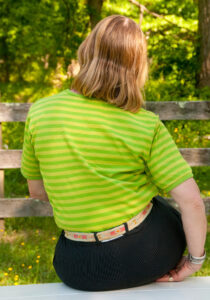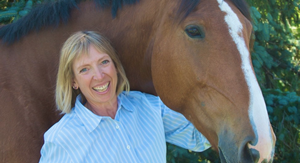Are you shorter on one side than the other? Does your horse bend easier in one direction? Do you have trouble weighting both seat bones equally? Here’s a quick tip to help lengthen your sides and make your seat bone weight more even.

Next time you ride notice the distance from your armpit to the top of the pelvis. Do you collapse (shorten) on one side? Is it the inside going left and right? Or to the same side all the time? Is your horse easier to turn toward your shorter side? Is he easier to canter toward your long side (left side long, left lead canter easier)? Does he consistently halt with the one leg behind him? Does this correspond to your longer or shorter side?
Riders often refer to themselves as “collapsing a hip” when they are uneven side-to-side. Anatomically you cannot collapse your hip because the hip is the ball and socket joint. If this were to collapse you would be in the hospital waiting for surgery! You can’t collapse your pelvis either because this is a solid boney structure.
You can “collapse” through your side, decreasing the distance between the armpit and the pelvis, by shortening the distance between the bottom of the ribcage and the pelvis (waist area) and/or bringing the ribs closer together on one side. When one side shortens the other side lengthens, meaning the ribs get further apart. In horse terms the shortened side is the soft side (generally the right) while the other side, which is lengthened, is considered stiff. When you shorten one side the weight is no longer equal on your seat bones. To even your two sides and your weight do the following exercise.

Sit on a flat surface. Put one hand underneath one seat bone. Which side did you choose first? You probably picked the side that shortens easier. You can lift the pelvis on this side and close the ribs to put you hand underneath. Repeat this movement several times. How much do you bend forward? How much to the side? Which ribs get closer together? What happens to the ribs on the other side? Which seat bone gets heavier? Does the weight bearing seat bone push straight down or do you shift forward toward the pubic arch, back toward the tailbone or do you roll over the outside edge?
Switch hands. What happens to your ribs on this side? Do they get closer together or do you do lean to get your hand underneath? Does the opposite seat bone get heavier, lighter or not change weight at all?
Alternate from side to side. What happens to the weight on your seat bones? Do you lift the same side of the pelvis either way? What do you do with your feet? How much do you push down? Do you use one or both feet? Is it the same foot regardless the side you are lifting or does this change depending on which side you shorten? Alternate several times making this movement easier and more similar as you go. Feel how the ribs have to soften on one side and lengthen on the other. Stop and sit with equal weight on both seat bones. Notice that the length of your two sides is more even.
Repeat this lesson on horseback. Do small movements because you could shift the saddle if you are not careful. Find the place where both sides feel equal. Notice if your weight is more even on the two seat bones.
 Use this Murdoch Minute to lengthen your two sides evenly. Softening your ribs on the long (stiff) side will allow the short side to lengthen. In the saddle you may find that equal length on the two sides doesn’t feel like equal weight on the two seat bones. This may be due to the saddle and/or the horse. Notice how your horse moves on circles and turns when your sides are even and always remember to enjoy the ride!
Use this Murdoch Minute to lengthen your two sides evenly. Softening your ribs on the long (stiff) side will allow the short side to lengthen. In the saddle you may find that equal length on the two sides doesn’t feel like equal weight on the two seat bones. This may be due to the saddle and/or the horse. Notice how your horse moves on circles and turns when your sides are even and always remember to enjoy the ride!
Wendy Murdoch is available for lessons and clinics in the Northern Virginia region as well as throughout the United States. She teaches riders of all levels and disciplines how to improve the horse’s performance by improving their body position. On-line join Wendy’s Facebook group Fans of the Murdoch Method and find more articles, blog and her new book 50 5-Minute Fixes to Improve Your Riding, based on the Murdoch Minutes at www.murdochmethod.com




